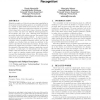524 search results - page 13 / 105 » A Term Recognition Approach to Acronym Recognition |
IROS
2007
IEEE
14 years 1 months ago
2007
IEEE
Reliable recognition of objects is an important capabaility in the progress towards getting agents to accomplish and assist in a variety of useful tasks such as search and rescue ...
GIS
2010
ACM
13 years 5 months ago
2010
ACM
Mobile intention recognition is the problem of inferring a mobile user's intentions from her behavior in geographic space. Such behavior is constrained in space and time. Cur...
ICASSP
2011
IEEE
12 years 11 months ago
2011
IEEE
We describe a new approach for phoneme recognition which aims at minimizing the phoneme error rate. Building on structured prediction techniques, we formulate the phoneme recogniz...
SPEAKERC
2007
Springer
14 years 1 months ago
2007
Springer
Higher-level features based on linguistic or long-range information have attracted significant attention in automatic speaker recognition. This article briefly summarizes approac...
NIPS
2003
13 years 9 months ago
2003
A recent area of significant progress in speaker recognition is the use of high level features—idiolect, phonetic relations, prosody, discourse structure, etc. A speaker not on...

